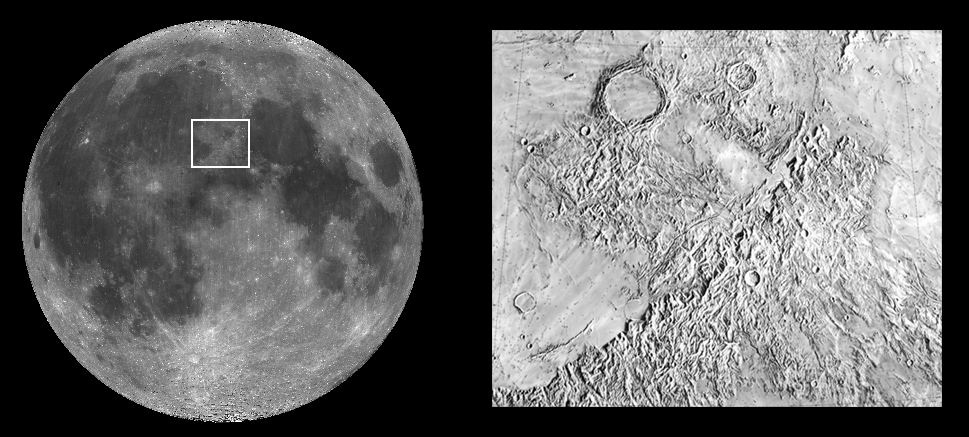
| Project Home | About the Scans | Browse Gallery | Image Map | Support Data | Resources | Ephemeris |
Featured Image - 09/30/2008
The Mighty Apennine Mountain Range
The Apennine Mountain Range forms the southeast portion of the main ring of the Imbrium Basin. The range rises from 2 to 5 km above the mare surface. For comparison, Pike's Peak in the front range of the Rocky Mountains on Earth has an elevation of 4.3 km above sea level. On the Apollo 15 mission, Astronauts David Scott and James Irwin landed on the Apennine Front and spent three days performing fieldwork, and collecting samples, which makes these mountains a focal point of intensive scientific study to this day.
Figure 1. Apollo 15 metric photograph
depicting Hadley Rille (the sinuous feature near the upper-center of
the picture), and the lunar Apennine Mountains, which start at the
upper left hand corner of the image and extend to the right of the
image. The white circle indicates the
Apollo 15 landing site. (Apollo Image AS15-M-1422 [NASA/JSC/Arizona
State University])
The large topographic relief of the Apennine Mountain Range is a product of the complex interaction between the Imbrium basin-forming impact and the pre-existing features in the region, especially the Insularum and Serenitatis basins. The lunar multi-ring basins like Imbrium are large, complex impact craters. The lunar impact basins formed between 3.92 and 3.72 billion years ago through collisions with asteroid-sized bodies. Later, most of these gargantuan impact features on the nearside filled with mare basalts. In fact, Mare Imbrium actually refers to the basalts that fill the Imbrium basin, not the basin itself. From studies of Apollo 15 rocks over the past forty years, we now know that the event that formed Imbrium basin actually happened several hundred million years before the eruption of the basalts that filled the Imbrium basin.

Figure 2. Global view showing the position of the
Apennine Mountains along the southeastern rim of the Imbrium Basin.
The detailed lunar shaded relief map (LSR-41 Montes Apenninus) shows that
the steep massifs change into low hills as you travel east across the
range. View of near side from the Clementine global albedo images (750
nm filter); source: LPI.
The initial Imbrium impact excavated and rearranged an enormous amount of crustal highlands material. Major structural uplift then occurred along the Apennine Front before the emplacement (landing) of the excavated ejecta materials. After the ejecta was emplaced, downfaulting occurred along the front and caused major seismic disturbances. One theory of ring formation states that slumping of material towards the basin center during the crater modification stage is responsible for the rings seen in the lunar multi-ring impact basins. Other scientists argue that multiple rings formed because of the intrinsic properties of the primordial lunar crust. Further in-situ study is needed to understand the formation of multi-ring basins and their influence on the geologic evolution of the Moon and other planetary bodies as well. The high resolution images of the Apennines and other basin-related features from the high-resolution (0.5 m/pixel) Lunar Reconnaissance Orbiter Camera will provide data to help illuminate their morphological and mineralogical intricacies while determining targets for future human lunar exploration.
References:
G. Heiken, D. Vaniman, B.M. French (1991), "Lunar Sourcebook, A User's Guide to the Moon." Cambridge University Press.
P.D. Spudis and J.W. Head (1977), "Geology of the Imbrium Basin Apennine Mountains and relation to the Apollo 15 landing site." Proceedings of the eighth Lunar Science Conference: 2785-2797.
P.D. Spudis (1993), "The Geology of Multi-Ring Impact Basins: The Moon and other Planets." Cambridge University Press. 1993.
Tweet
|
|
Space Exploration Resources |
|
 LPI LPI
|
